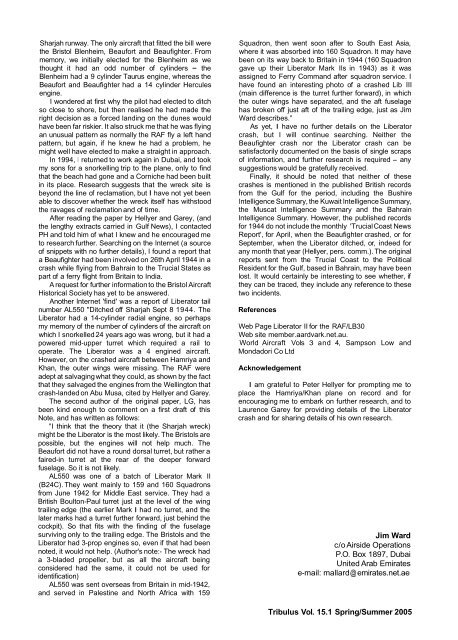Oman (Lepidoptera: Pieridae) - Al Ain Chapter, Emirates Natural ...
Oman (Lepidoptera: Pieridae) - Al Ain Chapter, Emirates Natural ...
Oman (Lepidoptera: Pieridae) - Al Ain Chapter, Emirates Natural ...
Create successful ePaper yourself
Turn your PDF publications into a flip-book with our unique Google optimized e-Paper software.
Sharjah runway. The only aircraft that fitted the bill were<br />
the Bristol Blenheim, Beaufort and Beaufighter. From<br />
memory, we initially elected for the Blenheim as we<br />
thought it had an odd number of cylinders - the<br />
Blenheim had a 9 cylinder Taurus engine, whereas the<br />
Beaufort and Beaufighter had a 14 cylinder Hercules<br />
engine.<br />
I wondered at first why the pilot had elected to ditch<br />
so close to shore, but then realised he had made the<br />
right decision as a forced landing on the dunes would<br />
have been far riskier. It also struck me that he was flying<br />
an unusual pattern as normally the RAF fly a left hand<br />
pattern, but again, if he knew he had a problem, he<br />
might well have elected to make a straight in approach.<br />
In 1994, I returned to work again in Dubai, and took<br />
my sons for a snorkelling trip to the plane, only to find<br />
that the beach had gone and a Corniche had been built<br />
in its place. Research suggests that the wreck site is<br />
beyond the line of reclamation, but I have not yet been<br />
able to discover whether the wreck itself has withstood<br />
the ravages of reclamation and of time.<br />
After reading the paper by Hellyer and Garey, (and<br />
the lengthy extracts carried in Gulf News), I contacted<br />
PH and told him of what I knew and he encouraged me<br />
to research further. Searching on the lnternet (a source<br />
of snippets with no further details), I found a report that<br />
a Beaufighter had been involved on 26th April 1944 in a<br />
crash while flying from Bahrain to the Trucial States as<br />
part of a ferry flight from Britain to India.<br />
A request for further information to the Bristol Aircraft<br />
Historical Society has yet to be answered.<br />
Another lnternet 'find' was a report of Liberator tail<br />
number AL550 "Ditched off Sharjah Sept 8 1944. The<br />
Liberator had a 14-cylinder radial engine, so perhaps<br />
my memory of the number of cylinders of the aircraft on<br />
which I snorkelled 24 years ago was wrong, but it had a<br />
powered mid-upper turret which required a rail to<br />
operate. The Liberator was a 4 engined aircraft.<br />
However, on the crashed aircraft between Hamriya and<br />
Khan, the outer wings were missing. The RAF were<br />
adept at salvaging what they could, as shown by the fact<br />
that they salvaged the engines from the Wellington that<br />
crash-landed on Abu Musa, cited by Hellyer and Garey.<br />
The second author of the original paper, LG, has<br />
been kind enough to comment on a first draft of this<br />
Note, and has written as follows:<br />
"I think that the theory that it (the Sharjah wreck)<br />
might be the Liberator is the most likely. The Bristols are<br />
possible, but the engines will not help much. The<br />
Beaufort did not have a round dorsal turret, but rather a<br />
faired-in turret at the rear of the deeper forward<br />
fuselage. So it is not likely.<br />
AL550 was one of a batch of Liberator Mark II<br />
(B24C). They went mainly to 159 and 160 Squadrons<br />
from June 1942 for Middle East service. They had a<br />
British Boulton-Paul turret just at the level of the wing<br />
trailing edge (the earlier Mark I had no turret, and the<br />
later marks had a turret further forward, just behind the<br />
cockpit). So that fits with the finding of the fuselage<br />
surviving only to the trailing edge. The Bristols and the<br />
Liberator had 3-prop engines so, even if that had been<br />
noted, it would not help. (Author's note:- The wreck had<br />
a 3-bladed propeller, but as all the aircraft being<br />
considered had the same, it could not be used for<br />
identification)<br />
AL550 was sent overseas from Britain in mid-1 942,<br />
and served in Palestine and North Africa with 159<br />
Squadron, then went soon after to South East Asia,<br />
where it was absorbed into 160 Squadron. It may have<br />
been on its way back to Britain in 1944 (160 Squadron<br />
gave up their Liberator Mark Ils in 1943) as it was<br />
assigned to Ferry Command after squadron service. I<br />
have found an interesting photo of a crashed Lib III<br />
(main difference is the turret further forward), in which<br />
the outer wings have separated, and the aft fuselage<br />
has broken off just aft of the trailing edge, just as Jim<br />
Ward describes."<br />
As yet, I have no further details on the Liberator<br />
crash, but I will continue searching. Neither the<br />
Beaufighter crash nor the Liberator crash can be<br />
satisfactorily documented on the basis of single scraps<br />
of information, and further research is required - any<br />
suggestions would be gratefully received.<br />
Finally, it should be noted that neither of these<br />
crashes is mentioned in the published British records<br />
from the Gulf for the period, including the Bushire<br />
lntelligence Summary, the Kuwait lntelligence Summary,<br />
the Muscat lntelligence Summary and the Bahrain<br />
lntelligence Summary. However, the published records<br />
for 1944 do not include the monthly 'Trucial Coast News<br />
Report', for April, when the Beaufighter crashed, or for<br />
September, when the Liberator ditched, or, indeed for<br />
any month that year (Hellyer, pers. comm.). The original<br />
reports sent from the Trucial Coast to the Political<br />
Resident for the Gulf, based in Bahrain, may have been<br />
lost. It would certainly be interesting to see whether, if<br />
they can be traced, they include any reference to these<br />
two incidents.<br />
References<br />
Web Page Liberator II for the RAF/LB30<br />
Web site member.aardvark.net.au.<br />
World Aircraft Vols 3 and 4, Sampson Low and<br />
Mondadori Co Ltd<br />
Acknowledgement<br />
I am grateful to Peter Hellyer for prompting me to<br />
place the Hamriya/Khan plane on record and for<br />
encouraging me to embark on further research, and to<br />
Laurence Garey for providing details of the Liberator<br />
crash and for sharing details of his own research.<br />
Jim Ward<br />
c/o Airside Operations<br />
P.O. Box 1897, Dubai<br />
United Arab <strong>Emirates</strong><br />
e-mail: mallard @ emirates.net.ae<br />
Tribulus Vol. 15.1 Spring/Summer 2005




